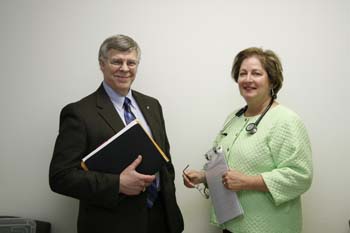| Back to Back Issues Page |
 |
|
VBPM Connection: News from your Doctor's Office December 10, 2013 |
Dear Patients and Friends,The Virginia Beach Premier Medical NewsletterDecember, 2013
If you would like to receive a copy of this free monthly newsletter electronically by email, go to the Newsletter Signup Page on the office website (www.vbpm1.com) and enter your email address in the signup box.
If you have a topic that you would like to see appear in the newsletter, please let us know at gjwarth@gmail.com. Twistle: Ask us about Twistle, a secure email application linking you directly to the office or to your doctor. Get answers to your personal medical questions. Change your appointment. Get your lab or x-ray results. Request prescription refills. Keep us informed. Ask the staff or your physician for more information, or click on the link...Twistle.
Testosterone Therapy Increases Cardiovascular Risk
Testosterone has been heavily marketed directly to consumers recently for treatment of "Low T" (low testosterone levels). Prior studies have shown some short term benefit to this therapy, but long term studies were lacking. Now we have new evidence about long term effects and it's not so good.
A new retrospective, randomized trial including 8709 male veterans over a mean period of 27 months, as reported in JAMA, Nov. 6, 2013, was stopped early because of the significant increase in adverse cardiovascular events (strokes and heart attacks) which occurred in the group of men who were taking testosterone versus those who were not (26% vs. 20%). A retrospective study is not as good as a prospective study. Nevertheless, there is some cause for concern and it makes the decision to start or continue testosterone therapy more worrisome. Unless the patient is truly symptomatic because of low testosterone levels, the risk probably outweighs the benefit. We might consider a short term trial in some cases, but if the treatment is not clearly beneficial, then it probably should be stopped.
New Guidelines for Cholesterol-lowering Therapy
Recommendations for treatment of high cholesterol levels have recently been changed by the American College of Cardiology and the American Heart Association...
Previously the guidelines have indicated that we should try to get the LDL (bad cholesterol) to below 100, or even below 70 in some patients at high risk. The new guidelines say that we should not be treating numbers because they don't necessarily correlate with outcomes. Rather, we should determine whether patients fall into one of the following four risk groups before starting statin therapy: 1. Patients who already have evidence of clinical atherosclerotic cardiovascular disease (already had a stroke or heart attack or other signs of arterial blockages). 2. Patients who have high LDL levels greater than 190. 3. All diabetic patients aged 40-75 with LDL cholesterol levels over 70, even without any evidence of cardiovascular disease. 4. Any patient with an LDL level over 70 and an estimated 10-year risk of cardiovascular disease greater than 7.5%, based on risk factors. The new risk assessment tool can be accessed through the ACA or AHA websites. Lifestyle modification is recommended for all patients regardless of cholesterol levels. Any lipid-lowering agents other than statins are discouraged with few exceptions. These new guidelines may actually reduce the requirement for statin therapy in some patients and may increase it in others. If you fit into one of the above four groups and you are not on a statin for reasons other than side effects or allergy, consult your doctor to assess your risk.
Use Technology to Monitor Health and Fitness
For all those techies out there that also embrace good health and fitness, consider asking for a Withings pulse monitor for Christmas. It is a very small rectangular device that you can keep in your pocket or clip to your belt or bra that can keep track of all your daily activity, tell you how many calories you burned. It can easily measure your pulse and even analyze your sleep patterns. Furthermore it automatically syncs with your IOS or Android smartphone throughout the day to log your information. See what you've done the previous day and try to outdo that level of activity the next day. It will also integrate with the My Fitness Pal app to show you how many calories you consume against how many you burn each day. Withings makes several other useful devices, like high tech weight scales and blood pressure monitors that can help you use the best technology available to keep you healthy.
Learn more on the Withings website at www.withings.com
Proton Therapy Cancer Treatment
You've probably heard about Proton Therapy for prostate cancer. It is also used for several other kinds of cancer as well, including breast, lung and brain. It is a relative new noninvasive, nonsurgical cancer treatment that involves radiation therapy but unlike the usual radiation therapy 'machines', this one focuses much more precisely on the cancer cells. There is much less radiation that gets to the surrounding normal tissues, so there are fewer side effects. Proton therapy is FDA approved and is covered by Medicare as well as many other insurance programs.
The only place that provides this in our area currently is the Hampton University Proton Therapy Institute in Hampton, VA. Find out more at www.hamptonproton.org or call 877-251-6838 for more information.
Echocardiograms
Not to be confused with an electrocardiogram (EKG or ECG), which tells about the electrical activity of the heart, an echocardiogram is an ultrasound of the heart that helps the doctor diagnose or rule out structural cardiac problems. It is easy to do in most cases, doesn’t require any needles or dye and gives a lot of information for the doctor about your heart. It can tell how well your heart is contracting, whether there is any enlargement of any of the four chambers of the heart, and whether or not you have any valve abnormalities. It can often tell whether you have had a heart attack in the past that you may not even be aware of. It is truly an indispensible tool for evaluation of patients when any heart problems are suspected.
When you talk with your doctor about the results, the phrase ‘ejection fraction’ (EF) is often used to tell how well your heart is contracting. Normally, the EF is anywhere from 50-70%. If the number is below 50%, this may be an indication of weakness of your heart muscle, perhaps caused by chronic coronary disease, diabetes, hypertension, alcohol and other conditions. If your EF is greater than 75%, that means your heart is contracting more efficiently and perhaps more vigorously than usual, which is not necessarily bad. This could be normal for you, or it could be an effect of medications. The echo may also give information about your heart valves, perhaps indicating a narrowing of one the valve openings, or it may show a leaky valve, in which case the blood sometimes flows backwards instead of forwards. Depending of the severity of these findings, it may help explain the cause of certain symptoms you may be having, like shortness of breath or ankle swelling. Most echocardiograms are done using the transthoracic method – that is, a transducer device is applied to the surface of the chest wall (on the skin) and ultrasound waves go through the chest wall and bounce back. Depending on how fast the waves come back in various positions of the transducer, the depth of different structures can be determined and one can ‘see’ the inner structure of the heart on a screen that can be recorded for the doctor to review. The EF is then determined by how dilated the left ventricle (the main pumping chamber) is when it is full compared to how small the cavity becomes when it is empty (right after a beat). If the size of the cavity reduces by 50% then that is what the EF is. Occasionally a different type of echo is performed when greater detail is needed, especially to look at valve structures, or if there is concern about any infection on one of the valves. This is called a transesophageal echo, which requires that the patient swallow a small probe, which then sits in the middle of the swallowing tube (esophagus) while the echo is being done. Since the probe is inside the body and very close to the heart, a much greater amount of detail can be obtained. Again, no needles or dye are required, but it is somewhat more uncomfortable because of having to swallow the probe. Of course, this probe is removed as soon as the echo is completed. The results of the echo usual take about 24-48 hours to get back after it’s done. It is often useful to compare the results of the new one with the old to see if there are any changes.
Testosterone
There are a lot of ads on TV about men with ‘Low T’, or low testosterone levels. There’s a considerable amount of controversy about the benefits vs. potential side effects.
First, the benefits seem to be few and inconsistent. It may or may not improve strength, sexual function, depression or quality of life. It may slightly reduce body fat. It may be appropriate for men with low morning testosterone levels and symptoms such as profound fatigue, lack of strength or decreased libido. It doesn’t seem to do much for erectile dysfunction in most men. The side effects include breast enlargement, sleep apnea, fluid retention with edema, prostate enlargement, prostate cancer, blood clots in the legs and lungs; and it can raise red cell counts to sometimes dangerous levels causing a condition called polycythemia. I’m not sure it’s worth it. If you do have documented low testosterone levels AND if you are symptomatic because of it, a six month trial might be appropriate. If you don’t notice any improvement in symptoms during that time, it would probably be best stop it, no matter what your 'T' level may be.
Antioxidants
Antioxidants are generally thought to be good for you. They help to neutralize the free radicals, the by-products of cellular metabolism that can potentially contribute to the development or worsening of a number of illnesses. Antioxidants can be found naturally in many plant foods. Tomatoes, beans, corn, cruciferous veggies (cabbage, broccoli, cauliflower, kale, etc.), pomegranate, coffee, tea, berries and curry contain lots of antioxidants. Also, a diet which is rich in plant-based foods like fruits, vegetables, legumes, and whole grains have additional benefits including fiber, protein, vitamins and minerals in addition to antioxidants. There is overwhelming evidence that diets like this offer tremendous health benefits. The supplements that you can buy in health food stores, on the other hand, may or may not be good for you, and there is little real evidence that they are. In fact, the antioxidant vitamin supplements like vitamin E, vitamin A and beta carotene are probably harmful in the doses usually provided in the pill supplements. So, when choosing between dietary antioxidants versus pill supplements, it appears the nutritional diet wins, hands down. Plus, these foods will tend to lower your intake of saturated fats and transfats, which is also a plus. As the saying goes, “You are what you eat”. Here is a recipe for a smoothie containing lots of antioxidants that you might want to try ( I found it in the most recent issue of the Mayo Clinic Health Letter)… Orange Peach Smoothie: Roast and peel the red peppers. Put all ingredients into juicer and process. Pour into 4 frosted glasses and enjoy. Nutrition analysis per 10-oz. serving, or about 1 1/4 cups: 175 calories, 1 gram (g) total fat (trace saturated fat, trace monounsaturated fat), 0 mg cholesterol, 95 mg sodium, 34 g total carbohydrate (5 g dietary fiber), 7 g protein Daily Value analysis per serving: 186% vitamin C, 54% manganese, 46% vitamin A, 9% zinc, 8% copper, 2% vitamin E and selenium; also contains lutein and zeaxanthin (no requirements have been established).
Sinus Congestion
Sinus congestion can interfere with sleep as well as proper breathing and is downright miserable sometimes. It can be caused by a number of different problems like allergies, vascular congestion or infection; and it may last just a few days as with the common cold or it may be chronic as in the case with allergies. Of course, you should check with your doctor for the correct diagnosis and specific treatment or medication that might help you resolve the situation. Here are some common things to do that may help you feel better… ~ Warm compresses to the face. ~ Breathe in steam from a hot shower or pan of hot water. ~ Short term use of nonprescription nasal sprays – Afrin or Neo-Synephrine, but no more than 3 days in a row to avoid the rebound effect. ~ OTC decongestants, but beware these can cause elevation of blood pressure and heart rate and urinary retention in males with prostate enlargement. ~ OTC pain medications like Tylenol (acetaminophen) or Advil (ibuprofen). ~Drink lots of fluids to keep the mucous membranes moist and make it easier to get rid of phlegm. ~ Your doctor may prescribe a nasal steroid spray, which can help provide some relief as well. ~ Antibiotics will generally only be helpful if you’ve had a true sinus infection for more than 7 days or if you’ve had fever, chills, sinus pain or thick purulent sinus drainage. Most milder infections are viral and will not respond to any antibiotic.
Perfume, Pets and Allergies
If you've ever known someone who has allergies, you know that sometimes exposure to certain things like pet dander and perfume can be quite distressing and can even precipitate a severe asthma attack. So, when coming into the office, in order to protect our patients and office staff, please refrain from wearing perfumes and bringing in pets. We will be forever grateful. About Our Office
Virginia Beach Premier Medical is a membership internal medicine practice specializing in comprehensive and compassionate, individualized and personalized patient-centered care. We pride ourselves on full continuity of care – in the office, in the hospital, or even at home.
If you would like more information about our practice please call us at 757-416-6750 or visit our website at www.vbpm1.com. Ask to speak with Brittany, our office manager, or Dr. Parks or Dr. Warth. We’d be happy to talk with you anytime.
Happy Holidays! |
| Back to Back Issues Page |





